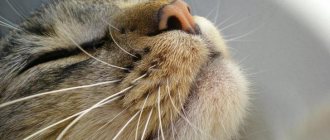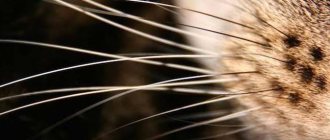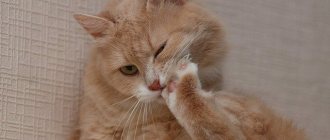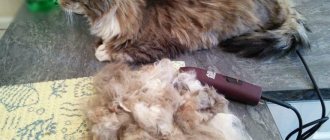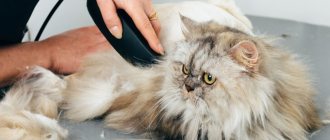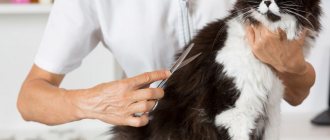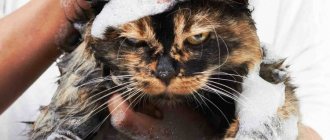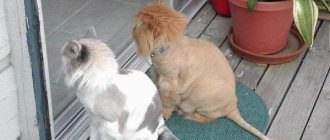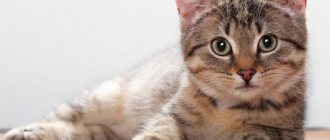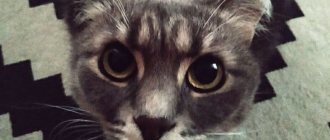Long, stiff whiskers give the cat a sense of respectability, and for the owner it becomes another reason to be proud of his pet in front of his friends. Why do cats really need them, and why can their condition be evidence of excellent health or a reason to contact a veterinarian? It's all about physiology - they perform olfactory and tactile functions, so the answer to the question whether a cat can have its whiskers trimmed will be negative.
Why do cats have whiskers?
A cat's whiskers act as an important sensory tool for cats, which they use for a variety of purposes.
All cats have excellent night vision, but they have difficulty seeing nearby objects. Their whiskers serve as a tool for detecting nearby objects that are too close to be seen well. Second, a cat's whiskers are so sensitive that they can detect small changes in air flow that may indicate nearby animals or predators.
The whisker has several other functions, such as triggering reflexes, a navigation tool in the dark, or measuring the width of a narrow space or entrance. They also help them climb and determine the distance to their prey. You see, whiskers are truly a cat's sixth sense.
How to properly cut a cat's hair
When cutting hair, it is advisable to find an assistant. He will hold the animal lying on its side, control the front legs with one hand and the hind legs with the other. It is necessary to fix the pet on the table surface quite firmly - the cat will escape out of fear, and the sound of the running machine will provoke it to escape. Try to use silent machines. It is necessary to cut cats according to a certain algorithm: start cutting from the sides, back and belly, move to the armpits, then the back. Then come the paws; if you wish, you can leave the “socks”. It is not necessary to cut the tail, but if you decide to tidy it up, leave a tassel at the end. If you decide to cut your cat's hair against the grain, use scissors and a special clipper, setting the cutting depth to 3 to 4 mm, which will prevent injury to the animal's skin. Do not forget to stretch the animal's skin in the area where the machine passes. Cutting against the grain is different in that a larger volume of hair is removed in one pass, but this method is mentally traumatic for the animal. After finishing the haircut, wipe the cat with wet wipes, or better yet, give it a bath to remove any remaining fur. Now all the fears are over, and she is ready to return to her normal life. This process is not simple, it has many nuances, and not all animals tolerate haircuts calmly. If you do not have enough skills to groom your pet on your own, it is better to contact a groomer: go to a special salon or call them to your home.
What happens if you cut off a cat's whiskers?
Since the whiskers are the vital organs of a pet, their loss leads to great difficulties. What happens if you trim a cat's whiskers?
Physiological or mental disorders
If a cat loses its tactile organ, then problems with its physiological and mental health are possible. It is known that without vibrissae the animal is poorly oriented in space. This occurs due to lack of information about the environment.
The cat begins to bump into objects and get stuck in passages that are too narrow. Cats cannot jump from one object to another. They are not able to fully hunt and obtain food. The loss of antennae is especially dangerous for yard representatives.
Often cats that are deprived of sensitivity become nervous and withdrawn. The mental state of the animals deteriorates sharply. They begin to avoid people around them, try to hide, or behave inappropriately.
Do cats grow whiskers?
Having found out why a cat needs a mustache, a person understands that cutting them is unacceptable. They are cut off only in case of injury or infection of nearby tissues. The procedure is carried out by a veterinarian to treat the problem area and prevent the development of complications.
Vibrissae are able to recover, but only if there is no damage to the hair follicle. Trimmed whiskers grow back in an average of 2-3 weeks, but sometimes the time period increases.
That is, take care of the cat's whiskers
The antennae do not require any special care. It is enough to choose food rich in proteins and minerals for the cat, so that his body maintains its tone. You should not trim your whiskers, but during bathing you should avoid getting the cat’s face wet, avoiding water and soapy water getting into the eyes and ears, and also without touching the sensitive hairs.
Naturally, these hairs should not be touched up with either artistic stationery paints or cosmetics. And not a single qualified grooming salon will offer you the procedure of cutting an animal’s whiskers.
If your male dog has lost his mustache, try to keep an eye on him for the first time, do not let him go on independent walks, and monitor the composition and freshness of his butt. If a cat does not have whiskers, do not tease it with flashing objects and do not throw it off your hands out of habit.
Explain to children that flashing your pet's whiskers is dangerous.
To prevent your cat from experiencing unbearable stress, shock, disorientation and apathy, be careful with her whiskers, and your beloved will delight you with a fun game more than once.
Does a mustache grow?
Whiskers that are lost, trimmed, or otherwise damaged will grow back in their original location. A completely lost mustache usually grows back within a few weeks. If your cat has had severe hair follicle trauma, the lost whiskers may never grow back, but this is quite rare.
Whiskers do not grow slower or faster depending on the cat's age, but at approximately the same rate throughout the cat's life.
The length of the whiskers is determined genetically, and once they reach a certain length, they will stop growing and will remain approximately the same length throughout your cat's life. The mustache does not grow indefinitely, so it does not need to be trimmed or trimmed.
General rules
You can work with the hair of some animal breeds with scissors.
To be safe, new haircuts for cats are done according to certain standards and recommendations. you should know who and how you can groom. It is allowed to cut a Persian cat and a pet with another long-haired breed using scissors, a mechanical hand or an electric machine. A Scotsman or a Briton can only be groomed with a machine, and scissors cannot be used to work with the hair of a Siamese cat. At the end of the process, the animal is bathed in warm water to remove small clipped hairs.
After the haircut, the cat should receive positive emotions in the form of a soothing, gentle stroking and tasty treats - this way the fright will go away faster. If the pet is shaved bald, the discomfort and anxiety will subside when the cat grows new fur 3-5 mm long, so that the animal does not attack its own tail, not perceiving it as its own, a brush is always left at the end.
Safety of the procedure
The absence of injuries is one of the main criteria for professional work. The fur is usually removed against the grain, but shaving the pet’s coat in the opposite direction is also acceptable, especially if these are small kittens or nervous adult purrs. Cutting hair according to hair growth makes it possible not to cause additional discomfort and stress to the animal.
Before treatment with a machine, the tummy is carefully trimmed with scissors, paying special attention to the area of the nipples so as not to damage them.
A special collar is necessary for animals that are prone to nervousness and aggression during grooming.
If the animal is nervous, put on a collar and groom without anesthesia. A pet wearing a collar does not see what is happening and is less nervous; besides, this way it will not be able to bite the hairdresser. Particularly aggressive patients are groomed with immobilization - the master's assistant firmly holds the cat by the paws and head, not allowing him to twitch and interfere with the process. If there are a large number of mats and it is necessary to completely cut off the fur, the “aggressor” must be groomed under anesthesia.
What does the absence of a mustache lead to?
The loss of a cat's whiskers directly affects not only its mood, but also its behavior and life in general. As mentioned earlier, the whiskers in cats are directly connected to the nerve endings, and this has a certain impact on the character of the cat that is forced to live without a whisker.
With the absence of whiskers, cats, of course, do not die, but, nevertheless, they are deprived of an important sensory organ. Many actions, such as hunting, navigation, movement, become much more difficult to perform. In this regard, when a cat loses its whiskers, it becomes lost, nervous, and aggressive. Until the whiskers grow back (this is a rather long process), she is in constant stress, and this is very harmful to the health of the animal. So, cats without whiskers have a very difficult life psychologically.
© shutterstock
What are the dangers of mustache loss?
The causes of whisker loss in cats have long been of concern to owners and veterinarians, but this issue has not yet been fully studied. It often happens that several cats living together pull out each other's whiskers. They do this secretly from the owners, so the owners often do not understand why the pet’s whiskers fall out and drag the beardless pet to the doctors. The version proposed by scientists suggests that in this way the animals are trying to subjugate their neighbor, whom they consider a competitor. Without a mustache, a competitor feels insecure and restless, and such a roommate is much easier to dominate, and he will snap back less.
Why you shouldn't trim your cat's whiskers
What happens if you trim a cat's whiskers? Often our pets are injured after an unsuccessful jump or a fight with a relative. With deep wounds on the face, veterinarians are forced to remove the hair along with the antennae in order to be able to treat the injured area. After shaving, cats' whiskers grow back faster than fur, which once again proves to us how necessary they are for the animal. It is absolutely forbidden to trim your pet's mustache!
The loss of whiskers is a very serious and difficult test for a cat, since without whiskers it loses the ability to navigate in space, hunt and check its food. This undermines self-confidence and the pet may become depressed, inactive and constantly in a bad mood.
Now you know how cats react to the loss of their whiskers, and they should not be cut. While the animal is waiting for the whiskers to grow, it is in constant anxiety and stress.
To find out why cats need whiskers, ethologists conducted hardware studies. They removed a pair of kittens' whiskers and observed the animals' behavior and changes in their brains. So scientists found out that if, after removal, a new whisker did not grow back for some reason, then the adjacent section of the muzzle with the vibrissae adjacent to it took over its functions. This once again proves how important such an organ is for cats.
Cats' whiskers, like their fur, have their own lifespan. Over time, they wear out and can no longer perform their functions. Mustache loss is an absolutely normal process; one or a pair of lost mustaches does not indicate deterioration in health or lack of vitamins. If the old whisker falls out, then in its place a new, young whisker is already growing to replace it.
It is important for cat owners to be able to distinguish when the whiskers have simply shed and when they are broken. The fallen vibrissae has a bulb at its end - a thickening, oval in shape.
If the whisker you found is missing a bulb and the edge has an uneven base, it means that the whisker did not fall out on its own, but broke off. If you notice that your pet's whiskers often break or fall out, contact your veterinarian for help. Perhaps the animal lacks vitamins or has caught some kind of infection.
If your mustache falls out
Loss of whiskers may indicate the presence of the following problems:
1. Skin diseases. In this case, by the loss of whiskers, one can judge whether the animal has diseases such as ringworm or atopic dermatitis. 2. Fungal diseases. In this case, the affected area of the cat's skin becomes itchy and itchy. 3. The presence of parasites in the body. The coat deteriorates due to metabolic disorders, helminthic infestations, and also when infected with fleas or ticks. 4. Endocrine diseases such as hypothyroidism. If they occur, the hair becomes matted and falls out. 5. Folliculitis is inflammation of the follicles. It is caused by bacteria, fungi, and viruses.
Loss of whiskers
Throughout their lives, cats completely change their whiskers several times. In place of the fallen ones, new ones necessarily grow, then they darken, die, fall out, and the process begins again.
Main reasons
If the loss of whiskers increases and the shift cycle shortens, the owner needs to pay attention to the living conditions of his pet in order to eliminate the cause. They may be as follows:
- In the cold season, when the owners begin to heat the room, air humidity drops and this has a bad effect on the condition of the whiskers, so it is recommended to humidify the air in various ways to improve the living conditions of pets.
- Cats are very clean animals, but sometimes people think that their pet needs help cleaning its fur. Unnecessary bathing, especially frequent, can lead to dry skin, itching, irritation, allergic reactions, even hair loss, so you should think several times before bathing your cat again.
- Changes in hormonal levels. Moving, separation from the owner, adolescence and other factors can negatively affect the condition of the mustache; in this case, consultation with a specialist is necessary.
- Some fearless cats love to admire the fire and simply singe the tips of their whiskers, so you should not leave an open fire unattended.
- Dehydration. Your pet must always have clean and fresh water in sufficient quantities. As you know, in the wild, the cat family will never drink where they dine, as the water may be poisoned, so if you notice that the animal is not drinking or drinking insufficient quantities, you can use this trick and place a bowl of water away from food.
- Lack of nutrients. If there is a deficiency of vitamins and minerals, the cat will have problems not only with its whiskers, but also with its health in general. The mustache will fall out, break, and may stop growing. It is imperative to contact a veterinarian so that he can select a diet for the animal’s speedy recovery. Food should be fresh, varied, have no chemical additives, and not be salty, sweet or sour. You should not give expired food or “yesterday’s” leftovers. You need to choose high-quality, proven brands that contain the vitamins and minerals your cat needs to maintain a healthy body.
Possible diseases
The problem with loss and brittleness of the whiskers is not always a consequence of poor animal husbandry: in some cases, these symptoms indicate an allergic reaction in the body. The most common foods that cause allergies are milk, chicken, fish, and food additives. In addition to problems with the whiskers, the cat develops itching, watery eyes, rashes on the skin, and hair may also fall out.
The problem with whisker loss can also indicate very serious diseases occurring in the animal’s body:
- Diseases of the endocrine system. It is divided into 2 types: hypothyroidism - a syndrome in which there is a decrease in the concentration of thyroid hormones. Hyperthyroidism is a clinical condition in which the thyroid gland overproduces the thyroid hormones triiodothyronine and thyroxine. The first signs of the development of one of the diseases are a sharp change in the animal’s weight, as well as thinning and loss of hairs, including whiskers.
- With the development of diabetes mellitus, the problem of vibrissae loss is also observed.
- Skin diseases. Dermatitis, fungal diseases, infections and other skin problems that cause irritation and itching can lead to hair and whisker loss.
- Various parasites that can settle on the animal’s body and inside the body can also cause vibrissae loss due to a decrease in general immunity, so it is recommended to regularly treat your pet for parasites.
Features of whiskers in cats
Cats' whiskers grow from birth, and their structure does not depend on the gender and breed of the animal. The only difference is the length and thickness of the hairs.
Structure
Cat whiskers have an interesting structure. Their roots are located in tissues with nerve endings approaching the hair bursa of the vibrissae. Each cat's whisker is associated with a specific part of the brain and is responsible for the functioning of a specific system.
Length
On average, cats' whiskers grow to 5-7 cm. The length of the whiskers depends on the breed of the animal. Maine Coons are considered to have the longest mustaches. A representative of this breed, nicknamed Miss, is listed in the Guinness Book of Records due to whiskers of 20 cm. But the hairless Canadian Sphynxes have short whiskers or no whiskers at all.
On a note. Cornish Rex and Devon cats have curly whiskers. This structure of the vibrissae is due to the presence of a special gene.
Thickness
The thickness of a cat's whiskers depends on the number of nerve endings, which give rise to tubercles at the very base of the whiskers. It is influenced by the sex of the animal and the location of the hairs. The female's mustache is thinner than that of the male. And the vibrissae growing on the cheeks are thicker than those located above the eyes and on the front legs.
Locations
Contrary to popular belief, cats' whiskers do not only grow on their faces. Thickened long hairs are also found on other parts of the animal's body. But they differ in quality from those located on the muzzle.
Cats' whiskers grow:
- above the eyes;
- near the nose;
- on the chin;
- around the labial pads;
- on the front legs.
The vibrissae growing on the forelimbs are almost invisible. But if you wish, you can see them just above the place where the dewclaw is located.
Causes of acne in animals
Do lost whiskers grow back in cats: even after trimming the hairs on the eyebrows and chin, they will be restored in 14-21 days. There are no special means to accelerate their growth - doctors advise using multivitamin complexes specifically designed for animals. They allow hairs to grow faster and become thicker.
Natural recovery will occur provided that no damage to the hair follicle occurred at the time of loss of the mustache. Animal care includes:
- protecting it from hot objects: fireplaces, gas and electric stoves, candles;
- using a special cap will help reduce the risk of head injuries;
- if a pet is placed in a cage for a while, then it will not be able to accidentally harm itself;
- an injured animal should not be allowed out into the street - there it can get under the wheels of a car, fall from a height, crash and damage not only its paws, but also its head.
Each new haircut of the whiskers will cause aggression in the pet towards its tormentor. If there are children in the house, then they immediately need to be explained why there are hard hairs on the cat’s body and what the risk of losing them is.
Trimming whiskers will not make a cat look beautiful; they play a big role in choosing a partner and communicating with familiar and unfamiliar relatives. Having lost their sixth sense organ, animals cannot hunt or move through previously unexplored places. Nature has protected furry pets, but it will take a long time to recover from the loss, during which time they can suffer seriously. Any stressful situation does not pass without a trace, then you should not be surprised at an animal that is aggressively opposed to its own owners.
Why does a cat need a mustache? This question can be asked by a child to his parents or by people who have taken a furry animal into their home for the first time and would like to find out themselves. It would seem that whiskers are longer hairs on the animal’s face. However, everything is not as simple as it seems.
It is quite difficult to unequivocally answer the question about the root causes of the painful condition of the skin. However, a list of potential threats that provoke the appearance of acne, especially in the area around the lips and on the chin, helps to find the very provoking factor in a particular case. Veterinarians believe that the causes of such rashes on the skin of cats are:
- low stress resistance of the animal’s body, as a result of which malfunctions of the sebaceous glands occur;
- poor hygiene of this area of the cat’s face (blackheads and blackheads resembling grains form on the chin, since this place is difficult to reach for independent licking);
- concomitant skin diseases that were not treated;
- abnormal functioning of the sebaceous glands and hair follicles;
- weakened immunity (acne in cats often appears when the body’s general defenses are reduced);
- the use of low-quality plastic dishes for feeding cats (the pores of bowls made of such materials collect a huge amount of bacteria, potentially dangerous to the pet’s skin).
Cat's whisker tongue
Communication is the most important thing a cat's whiskers do. With the help of vibrissae, she gives signals by which her mood can be determined:
- If a cat's whiskers are directed forward towards the object of study, then the animal is friendly and ready to communicate.
- If a pet presses its whiskers, it means it is scared or angry. In this case, it is better to temporarily refuse to communicate with the animal, otherwise there is a risk of being harmed by its claws and teeth.
An effective method to immobilize a cat
The process of immobilizing young healthy cats includes the following steps:
- Attaching the clip to the cat's scruff. You need to select a clothespin or clip approximately 5 cm in size and place the device on the withers directly behind the ears. Each owner can choose what exactly to pinch the scruff of the neck on their own. You need to look at the cat’s reaction to see what suits him best. If a paper clip puts too much pressure on the skin, the cat will not tolerate the pain.
- It is necessary to place the pet on its side. Since the cat relaxes too much after the clamp, he may involuntarily fall on his own. If this does not happen, you can gently press on the hind legs to remove resistance. You can tell that the cat is completely relaxed by his behavior. He tends to pull the lamps towards his muzzle, curls up into a ball, and places his tail between his paws. If the cat cannot be laid on its side, it continues to stubbornly stand on its feet and tucks its tail, which means it is not calm and is very scared.
- Using additional clothespins. The reception will help to completely relax the animal. To do this, several clamps must be placed a little further than the first one on the back of the neck along the spine. If the cat starts to get violent, then all the clamps need to be removed.
- Also, the method of placing a clothespin anywhere along the back along the spine may work for some cats, but greater effect can only be achieved when placed on the neck.
- After a few minutes, the clothespins need to be removed. However, the duration of the resulting peace of mind is sometimes completely unpredictable and is determined on an individual basis. Some cats are immobilized during the entire grooming and nail trimming procedure, while in other cases the animal can be deactivated for a short period of time.
According to veterinarians, clothespins cannot cause harm to the skin. But after some time, the cat may begin to show dissatisfaction; there is no need to shock the cat for a long time.
When keeping pets, there is often a need to perform certain procedures that require their immobility. If this is a cat, then he needs to trim his claws, get a haircut, perform medical procedures, for example, give injections
With all these procedures, it is important to know how to immobilize a cat correctly. After all, they are all stressful for the animal, which means it can behave completely unpredictably, injuring both itself and those around it.
To keep the cat from moving, it is not necessary to use sedatives or other tranquilizers; you can get by with another working method.
Whiskers help cats determine if they're passing
Have you ever seen how a cat can fit into the narrowest of spaces? How do they know in advance whether they will fit inside or not? It turns out their mustaches act like measuring tapes.
Before the cat squeezes into the small, narrow space, they carefully poke their head into the hole. It may seem like they are trying to feel something when they do this because you will notice their nose and upper lips moving as they do this.
They actually measure the width of the hole by moving their whiskers and touching the edges. The ends of the whiskers on each side are positioned the width of your cat's body. They know that if their whiskers come through, so does the rest of their body.
© shutterstock
How to help a pet who has lost its whiskers
There are no specially designed drugs or products to accelerate the growth of whiskers in cats. With a healthy hair follicle, the vibrissae grow on their own. There is no need for additional care. Veterinarians emphasize that there is no need to use any ointments or creams, this will not bring any benefit.
If it happens that your mustache breaks or falls off, you need to diversify your diet. It is advisable to include the following products in your daily menu:
Already in the 3rd week, the hairs grow a couple of millimeters, which allows the four-legged pet to again adequately respond to the world around it. Over the next 4-10 weeks, the vibrissae acquire the required size, and their receptors are completely restored.
What functions do whiskers perform in cats?
Vibrissae perform several important functions. A cat needs whiskers to:
- Orientate yourself in space, especially at dusk. Although cats see well in weak moonlight, sensitive vibrissae help them obtain additional information about objects nearby.
- Assess the dimensions of surrounding objects and the distance to them. Before crawling under the sofa, the cat will use its whiskers to check whether it can get there.
- Explore new things, people and animals. Using its whiskers, the cat receives information about unknown objects and objects.
- Protect your eyes. When a cat makes its way through the bushes in the dark, its hard whiskers come into contact with protruding branches and it instinctively lowers its eyelids.
- Find out about weather changes. With the help of their whiskers, cats sense the slightest changes in temperature and humidity. It is believed that they anticipate the approach of natural disasters.
- Calculate the trajectory of the jump. Using its whiskers, the cat determines the speed and direction of air currents. Thanks to this, she calculates how best to jump.
- Receive information about food. The cat uses its whiskers to check the freshness and temperature of the food.
- Determine the location of the prey. Using its whiskers, the cat detects the vibrations in the air created by the mouse's escape and knows how far away it is. And the vibrissae located on the front legs allow it to control the condition of the caught prey.
From the mustache straight to the brain: how do they work?
It is interesting that the information that comes from the sensitive mustache and from the eyes goes through one channel - the ternary nerve.
This allows the brain to summarize signals, process them and create a three-dimensional picture of the world around us. Depending on the lighting, the pupil tends to expand or contract. In complete darkness, it is maximally expanded, meaning it has difficulty focusing on nearby objects. The mechanoreceptors, which are located at the base of the mustache, do not need light; they only pick up the vibration of the hair from air currents. This allows you to determine the location and distance to an object and avoid obstacles in time, even in complete darkness.
The very first hairs that kittens develop in the womb are vibrissae.
As we know from school physics courses, air not only never stands still, but also changes its direction when colliding with an object. Sensitive vibrissae are capable of recreating a clear picture of the surrounding environment based on air movement data. For this reason, it is impossible to approach a cat unnoticed.
She may not see or hear you, but she catches the reflected air flow. The only way to catch the animal by surprise is to approach from downwind.
Vibrissae in cats in the wild
By nature, a cat is, first of all, an excellent hunter; as they say, it’s in her blood. And here the mustache plays an important role. Thanks to them, a cat can close its eyes at the right moment to protect them from a branch or blade of grass while making its way through thickets and bushes. And then continue the hunt without taking your eyes off the victim. When prey is caught, the predator holds it in its teeth out of sight. At this moment, only the outstretched mustache helps to assess the situation and control the victim’s behavior.
Confident cat jumps are accomplished solely thanks to the vibrissae. By moving them, the cat determines the direction and speed of the wind, this allows it to adjust the force of the push and the position of the body in the jump.
Particularly long and coarser hairs can be seen throughout the coat. They are much softer and do not play such a significant role as a mustache, but they also have some sensitivity. These hairs help the cat determine the nature of touches and distinguish between dangerous and pleasant contacts.
When meeting a cat, you can easily determine its attitude towards you. Interest, curiosity and friendliness if the mustache is directed forward. But if the animal presses them to its muzzle, then it is better to hold off on stroking, the cat is aggressive. The movement and location of the whiskers is a kind of “gesture language” of these animals.
Features of the structure of whiskers in cats and cats
There are no differences in the structure of the vibrissae in cats and male cats. This organ is not related to the gender of the animal and performs the same functions. The difference may be slight in length and thickness. But this is determined solely by genetics.
Locations
There is a common belief that cats have whiskers only on their faces. Long, thick hairs have been seen and known by everyone here. They are located:
- around the nose;
- on the lip pads;
- above the eyes;
- on the lower jaw, more precisely, on the chin.
But there are the same ones on the front legs. True, they are not so noticeable. But just look closely at the paw just above the place where the dewclaw is located, and you can easily spot them.
Vibrissae are located not only on the face, but also on the cat’s paws
Length
The length of the whiskers on a cat's face is on average 5–7 cm. But in this matter, much depends on the breed. So, the owners of the longest mustaches are Maine Coons. Their whiskers add incredible charm to their already charismatic appearance. In sphinxes, on the contrary, the vibrissae are very short, and often also curled. The owners of curly mustaches are cats that carry the Rex gene. The name of these breeds contains the prefix “Rex”. For example: Cornish Rex, Devon Rex and others.
The length of the whiskers is also determined by the cat’s nutrition. If it is balanced, the mustache will be truly luxurious.
There is a popular belief that the longer a cat's whiskers, the more mice he catches. So our ancestors considered this relationship.
Thickness
The thickness of the whiskers varies only by gender: cats have thicker whiskers than cats. You can also identify differences by location:
- the mustache on the cheeks is much thicker than above the eyes;
- on the front legs the vibrissae are only slightly ahead in thickness of the animal's guard hairs.
In general, the thickness of the vibrissae is explained by the fact that the place where each hair grows is rich in nerve endings. And if you consider that their number is quite large, then it becomes clear why the vibrissae has a tubercle at the base.
Other structural features
The vibrissae themselves are already a very mysterious organ. Each hair has a connection with its own part of the brain and is responsible only for a specific function. Therefore, if a cat loses one of its antennae, it temporarily experiences problems in hunting, coordination, touch, etc.
Each antennae is equipped with nerve endings and has its own “representation” in the brain
Photo gallery: mustachioed cats
Maine Coon is a breed that is distinguished by the length of its whiskers. Don Sphynx cats are allowed small curled whiskers. For some cats, whiskers are not only a necessity, but also a decoration. Fluffy cats have whiskers to match them.
DOG NOSE
A dog and its owner are walking down the street. The owner looks at the posters that are pasted on the fence, reads the newspaper on the stand. And the dog is always pulling him somewhere. She wants to sniff the pillar on the corner, the steps of the store, and the fence around the school. Why does she need this? But why. And the post, and the steps, and the fence, and the whole street, with its houses, shops and fences, are the same for a dog as posters and newspapers are for its owner. She gets news from them. Of course, not human ones, but our own dogs. Now she found out that a mongrel from a neighboring entrance was passing by the post, a familiar poodle was waiting for the owner near the store, and some strange dog was chasing the cat near the fence. The smells told the dog about all this. It is difficult for us humans to even imagine what mass of smells dogs can distinguish and how well they remember them. One day a man and his dog were sailing on a steamboat. Islands appeared and disappeared on the horizon. The dog was dozing calmly, but suddenly jumped up and rushed to the side. She barked and squealed, looking into the distance, and there could be seen another island. The owner of the dog became interested, and he went to the captain and looked at the map. It turned out that on the horizon was the very island where he had lived for a whole month last year. And now the dog recognized the island by its smell several kilometers away. Why do dogs have such a good sense of smell, why is their nose better than a human’s?
Both humans and all animals have special olfactory cells deep in the nose that sense odors. The more of these cells, the better the sense of smell. So, dogs have two hundred times more of these cells than humans. They inherited them from their wild ancestors - wolves, whose subtle sense of smell helps in hunting. People have long learned to use a dog's sense of smell and its power. Dogs track game by scent and find lost things. There are detection dogs, and there are gas dogs - they sniff out where gas comes out of damaged pipes. During the war, sapper dogs became famous for finding mines by the smell of explosives. There are even dog geologists. One shepherd dog was trained to find rocks containing valuable ore, and found these rocks four times more often than the most experienced geologist. But dogs aren't the only ones with a good sense of smell. Wild boars, for example, find and tear out edible roots from the ground by smell. And if mice are offered several pieces of different cheese to choose from, they will sniff it and find the most delicious one by smell.
How many whiskers does a cat have?
Cats have 24 whiskers on their faces, 12 on each side. The mustache is located in the same positions on the left and right. Thanks to this symmetry, cats can accurately measure and sense their environment.
in cats, the life of cats is great for cats vibrissae keeping cats in for cats “Stopstress” Missy Maine Coon breed Missy Maine Coon breed some breeds, for example, from breed affiliation, features of breed sex, strong domestic breeds, best breeds for
dog comments articles and rodent walk contents area reasons site feeding cat follow reply products always
